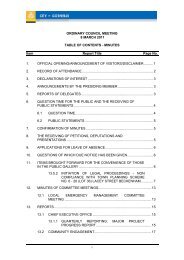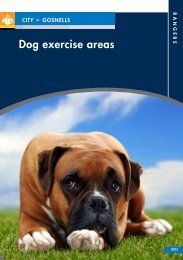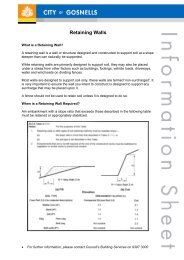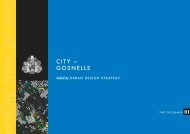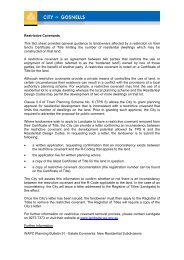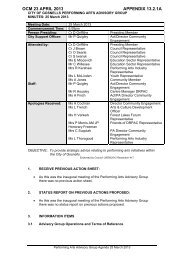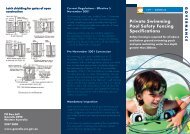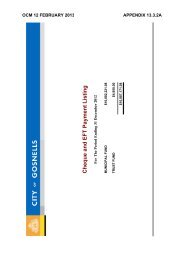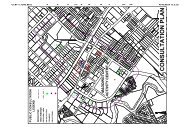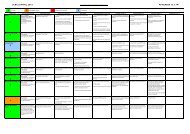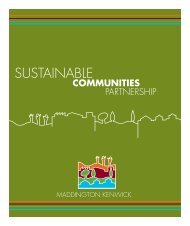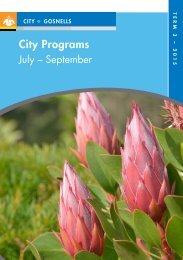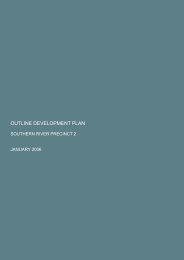Summary - City of Gosnells
Summary - City of Gosnells
Summary - City of Gosnells
You also want an ePaper? Increase the reach of your titles
YUMPU automatically turns print PDFs into web optimized ePapers that Google loves.
Methods 29The pattern <strong>of</strong> vegetation distribution that is present in many palusplains on the SCP presents some specificdifficulties in wetland management category evaluation and in wetland management. Palusplains are laterallyextensive, and on the SCP they are largely cleared <strong>of</strong> native vegetation and <strong>of</strong>ten accommodate a plethora <strong>of</strong>poorly-planned and poorly-managed land uses. The MKSEA is not an exception in being a patchwork <strong>of</strong>small native vegetation remnants, paddocks, vacant derelict dwellings, dams and drains, areas <strong>of</strong> dumped fill,roads, houses, factories, poultry sheds, truck yards, mechanical workshops, warehouses, quarries and privaterefuse dumps. If the vegetation <strong>of</strong> a ‘patchwork’ palusplain is evaluated over its entire area, the vegetationcondition is, effectively, averaged over the large area involved. This method <strong>of</strong> evaluation would be likely toresult in a MUW or REW category, regardless <strong>of</strong> the high conservation significance <strong>of</strong> remnants <strong>of</strong>vegetation that may be present. The alternative method <strong>of</strong> evaluation, which is more commonly used, is toevaluate parts <strong>of</strong> an extensive palusplain as several, separate entities (after defining the boundaries that are tobe used in the assessment). In this case, the evaluation is likely to result in a MUW or REW category for theunvegetated units and CCW for the small vegetated units.Although the process <strong>of</strong> splitting an extensive wetland into several management units may be the mostobjective way <strong>of</strong> recognising small areas <strong>of</strong> high conservation value vegetation, it serves to reinforce thefragmentation <strong>of</strong> ecological units that are already critically small. Such splitting up <strong>of</strong> a palusplain intoseveral management units does little to recognise that ecological functions and processes, such asgroundwater flow, unify parts <strong>of</strong> a palusplain into a single unit and help to maintain areas <strong>of</strong> valuablevegetation. It also prompts the further loss <strong>of</strong> scarce palusplain habitat on the SCP. Palusplains that areclassed as ‘degraded’ or ‘completely degraded’ in terms <strong>of</strong> native vegetation <strong>of</strong>ten retain their geomorphicintegrity, soils or other attributes. Some can be restored and replanted, and can also be recolonised by nativeflora and fauna from adjacent native vegetation. If managed appropriately, such areas can provide additionalhabitat suitable for the reintroduction <strong>of</strong> flora that is currently threatened because its former range hascontracted to a small fraction <strong>of</strong> its previous size due to development.The approach taken in the current evaluations <strong>of</strong> wetlands in the MKSEA was to initially split extensiveareas <strong>of</strong> palusplain/floodplain into separate units based on vegetation condition. The wetland managementcategories <strong>of</strong> these wetlands were then evaluated separately via two questionnaire methods (VCSRG, 1998and EPA, 1993) and according to vegetation condition. Subsequently, the opportunities for maintenance andenhancement <strong>of</strong> conservation values and ecological functions were considered in the discussion <strong>of</strong> linkage <strong>of</strong>areas with high conservation values via buffer zones and ecological corridors.3.4 Survey LimitationsEPA Guidance Statement for Terrestrial Flora and Vegetation Surveys for Environmental ImpactAssessment in Western Australia (EPA, 2004b) identify the main factors that can limit and constrain suchsurveys. The current project was evaluated against these factors (Table 3.4) and several significantlimitations were found to be present. These constraints are addressed below.1. Completeness and intensity <strong>of</strong> the surveyAn appropriate level <strong>of</strong> survey was used for the high conservation value flora and vegetation <strong>of</strong> the areain accordance with EPA recommendations. The only aspect <strong>of</strong> this survey that was not completed wasthe investigation <strong>of</strong> several blocks that clearly had remnant vegetation but to which landownerswithdrew or did not grant access (see below).Some investigations into the stratigraphy and hydrology <strong>of</strong> a sample <strong>of</strong> sites were made during thecurrent field survey and hydrological features <strong>of</strong> high conservation significance were found that werenot known previously in the MKSEA or in the Greater Brixton Street Wetlands. However, the currentsurvey <strong>of</strong> the MKSEA was primarily a biological survey, not a detailed hydrological study. Theintensity <strong>of</strong> the hydrological study was below that required to characterise the essential features <strong>of</strong> thehydrological cycle in the MKSEA and the hydrological interactions between the MKSEA and theGreater Brixton Street Wetlands. The hydrogeology <strong>of</strong> the Greater Brixton Street Wetlands is relativelywell-known thanks to a detailed, fine-scale hydrological field study by the V & C Semeniuk ResearchGroup (2001). The results <strong>of</strong> this study and the ongoing monitoring <strong>of</strong> the bores after 2001 by the V &Tauss, C. and Weston, A.S. (2010). The flora, vegetation and wetlands <strong>of</strong> the Maddington-Kenwick Strategic Employment Area.A survey <strong>of</strong> the rural lands in the vicinity <strong>of</strong> the Greater Brixton Street Wetlands. Report to the <strong>City</strong> <strong>of</strong> <strong>Gosnells</strong>, W.A. Version 18.04.10



